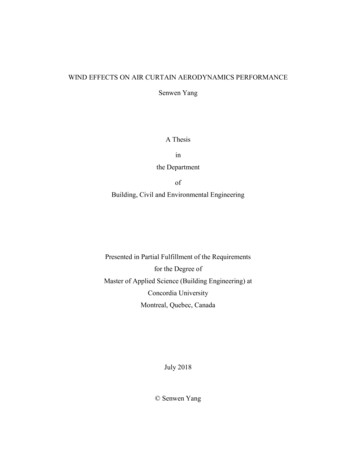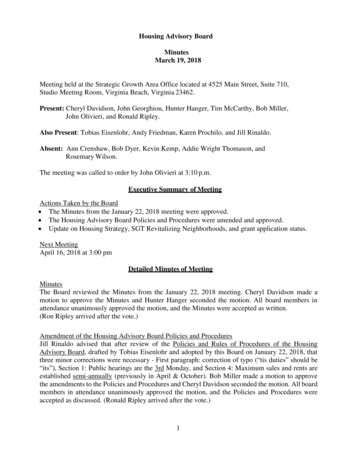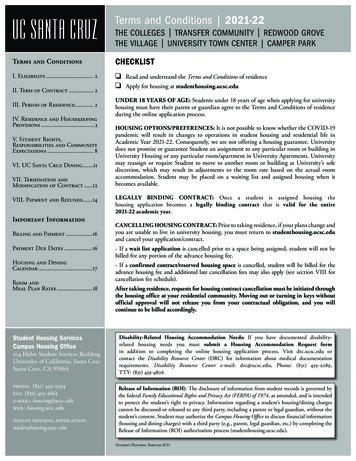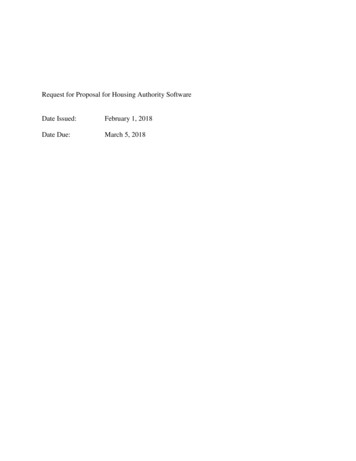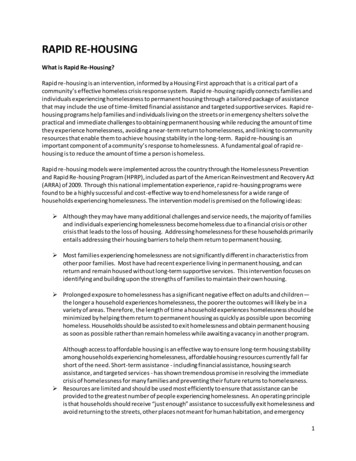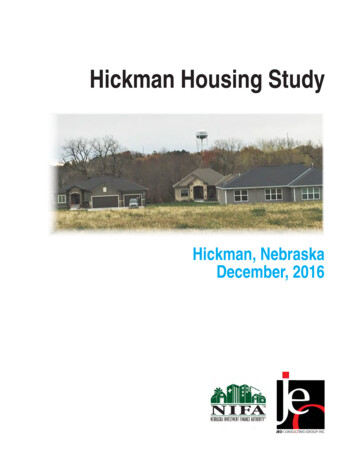
Transcription
Hickman Housing StudyHickman, NebraskaDecember, 2016
AcknowledgementsMayor, City of HickmanDoug HansonCouncil MembersDave DykmannJustina ZiemannPhil Goering Steve NorenRichard HarmsDoug WagnerPlanning CommissionMarna Cochell, ChairNancy BrandtChad Parker Walt NelsonAustin KlingenbergTroy PomajzlEldren EchternkampDave KulwickiKeith JantzenNathan Claassen, AlternateCity StaffSilas Clarke, City AdministratorKelly Oelke, City ClerkHeidi Hoglund, Director of Permitting, Zoning, and CodesPlanning ConsultantJEO Consulting Group, Inc.Study made possible with funding from theNebraska Investment Finance AuthorityIIHickman Housing Needs Study Hickman, Nebraska
Table of ContentsHickman Housing Needs Study Hickman, NebraskaExecutive Summary1Community Profile2Existing Housing Analysis6Community Engagement14Projections20Implementation23III
IVHickman Housing Needs Study Hickman, Nebraska
Executive SummaryExecutive SummaryThe City of Hickman is located in southern LancasterCounty, directly south of Lincoln, NE. The community iswell within the Lincoln Metropolitan Statistical Area. Thisstudy exists to examine the housing market of Hickman anddocument area housing data and conditions. The goal of thedocument is to provide support for community decisions andstrategies regarding housing improvement and developmentin the community. It is understood that housing is an integralcomponent of economic development, quality of life, andoverall community success. A portion of this study and theComprehensive Plan update were funded by NebraskaInvestment Finance Authority’s (NIFA) Housing Study GrantProgram. The Housing Study Grant Program is designed tostimulate ideas for regional, community and neighborhoodplans encompassing housing, community, economic, andplace-based development opportunities in Nebraska.Study ProcessThe Hickman Housing Study was developed in conjunction with a major update to the City’sComprehensive Plan. Within the context of the planning process, public participation involved aseries of focus group meetings, an on-line public forum, and engaging select stakeholders in housing,community and economic development to discuss housing needs and opportunities in Hickman.The process was overseen by a selected steering committee consisting of various stakeholders andcommunity leaders.The first step in the study is to develop a profile of Hickman. This profile is an understanding andanalysis of Hickman, its residents, and its housing stock. The purpose of the profile is to identify whothe residents of Hickman are, and what their future needs may be. This analysis also carries over toidentify a potential market for future residents of the community and examining the appropriate housingoptions to attract population growth.The engagement step is a critical component of the planning process. Citizen participation is of theutmost importance in identifying the strengths, weaknesses, opportunities, and threats (SWOT) forhousing development in the community. The residents, workforce, and business leaders of Hickmanhave the most intimate understanding of the issues facing the community and housing stock.The third step in the planning process includes projecting future housing needs and demands. Utilizingsocioeconomic data and establishing trends of the existing population, a forecasted population baseand housing demand are developed. These projections are designed to assist community leaders andprivate concerns in policy and investment decisions.Stakeholder input, in conjunction with highlighted community data, is utilized in the final step ofthe planning process. An implementation plan that complements the recommendations of theComprehensive Plan was developed based on input gained throughout the planning process andtargeted opportunities. This community action plan is created with strategies for addressing issues thatmay currently prohibit housing development in the community.Hickman Housing Needs Study Hickman, Nebraska1
Community ProfileCommunity ProfilePopulationHickman’s historical growth is best summarized by its recent, rapid growth. The growth of the “babyboomer” era has given way to even more growth pressures within the most recent decades. This growthcan largely be attributed to the community’s quality of life amenities increasing connectivity to the City ofLincoln. These growth trends weigh heavily on projections of future population growth in the community.The goal of this housing needs study is to identify strategies to develop housing that will accommodate andfacilitate these growth trends, while managing the rate of growth at an appropriate level.Figure 1.2Hickman Historic PopulationHickman Housing Needs Study Hickman, Nebraska
Community ProfileFigure 2.Comparison Population TrendsComparing Hickman’s growth with similar cities gives context to its growth and current population.Comparable cities were selected based on their size, but also their relative proximity to Metro areas.Over the span of the past 40 years, Hickman’s growth has exceeded that of Bennington, just outside ofOmaha. Hickman’s growth mirrors that of Gretna’s prior to the year 2000. Gretna’s growth since hasbeen fueled by it’s connectivity to Omaha, but also it’s proximity to Interstate 80, making it accessible toLincoln as well as a driver for economic growth.Housing choice is imperative to growth on a regional perspective. With all peer communities locatedwithin Metropolitan Statistical Areas, their growth respective to one another is largely determined byconnectivity to job centers, quality of life amenities, and appropriate housing choice.Hickman Housing Needs Study Hickman, Nebraska3
Community ProfileFigure 3.Hickman Age Cohort - 2010Age structure analysis providesa snapshot of the currentpopulation of a community byits respective age cohorts andgender. It also serves as abaseline for future populationprojections by allowing theviewer to track age groupsthrough time compared witharea birth, mortality andmigration rate trends.The most notable segment ofthe population lies in the agegroups of 30-34. Hickman’sability to attract young adultsand families has been theprimary driver of its populationgrowth. This group has beenattracted to the quality NorrisSchool District, housing choice,and amenities of a smallcommunity. The proximity toLincoln allows young families toenjoy raising children in a smallcommunity and school district,while accessing the large jobpool of the larger metro area ofLincoln.The children of these youngfamilies will be served by childcare facilities and the localschool district. An annualevaluation of the capacity inthese areas will help maintaina continued attraction by youngfamilies.4Hickman Housing Needs Study Hickman, Nebraska
Community ProfileFigure 4.Hickman Age Cohort TrendsIn looking at recent trends of specific age cohorts, the most notable growth has occurred in youngfamilies. These families are characterized by children under the age of 19 and adults between theages of 25 and 44. This growth has caused the median age for the community to drop from 32.5 in2000 to 31.8 in 2010. However, every cohort above the age of 50 experienced growth over the mostrecent Census decade. This trend will weigh heavily on the community’s need to provide housingopportunities and quality of life amenities to retirees and seniors.Community’s often find that older generations are just as mobile as young families and professionals.Many retiree’s seek the opportunity to downsize and relocate near family as part of their grandchildren’ssupport system and to maintain their own family support system nearby.Hickman Housing Needs Study Hickman, Nebraska5
Existing Housing AnalysisExisting Housing AnalysisFigure 5.Hickman Housing Stock AgesMirroring its historic population growth, the development of Hickman’s housing stock has experiencedperiods of rapid growth. The facilitation of population and housing growth has been determined by theavailability of land and infrastructure for the development of new housing subdivisions. As of the Fallof 2016, Hickman’s most recent subdivision is filling up and lacks many vacant lots for construction.However, a new subdivision has been preliminarily approved, with construction likely to begin in 2017.6Hickman Housing Needs Study Hickman, Nebraska
Existing Housing AnalysisFigure 6.Hickman Housing TrendsSelect housing characteristicsshowcase trends forming inthe local market. These trendsassist in housing demands projections and the housing stock’sability to serve a growing population. Figure 6 displays selectcharacteristics in which trendsand assumptions can be made.Hickman’s household size hasremained steady over the mostrecent Census decade, wheredata is available. Vacancy rateshave also remained extremelylow for both owner and renter-occupied units. These trendsshowcase the level of demandfor owner housing from youngfamilies in the Hickman area.Figure 7.Hickman Occupancy TenureHickman Housing Needs Study Hickman, NebraskaThe demand and market forowner-occupied housing unitsis further detailed in Figure7. Where most communitieshave a home-ownership rate inbetween 60 to 70 percent, Hickman’s rate is above 70%. Theestimated statewide average in2014 was 67%. Maintaining abalance of ownership and rentalopportunities is important to asustainable housing market andcommunity growth. Establishingadditional quality and affordablerental opportunities is recommended to provide a diversehousing supply, catering to awider demographic.7
Existing Housing AnalysisIncome is a major, if not the definitive, factor in terms of housing choice for a resident. The householdincome levels as reported by Census are documented in Figure 8. Hickman’s median householdincome of 63,750 is well supported by the distribution of population at higher income levels. Anestimated 65.5% of Hickman households have income levels at, or above that of the Nebraska medianhousehold income of 52,686 in 2014. Showing a high level of income independence, over 83% ofhouseholds in Hickman receive their income from earnings, rather that fixed income sources of SocialSecurity or personal retirement savings.Figure 8.8Hickman Household Income - 2014Hickman Housing Needs Study Hickman, Nebraska
Existing Housing AnalysisFigure 9.Hickman Homeowner CostsThe relationship between income and housing is furtherexplored in Figures 9 and 10. The U.S. Census definesmonthly housing costs as the total cost of owning orrenting a home, or the total of mortgage (rent), taxes,insurance, and utility costs. A total monthly housingcost in excess of 35% of household median income isconsidered to be a burden to the household.Of owners, the median monthly cost of ownership wasan estimated 1,354 in 2013. This represents lessthan 1% of the estimated median home value and25.5% of the monthly median household income inthe same year. 58.2% of households in Hickman payless than 25% of their household income on housingcosts. Any additional household income is beneficialto the community. It is assumed that income notspent on housing can be applied towards savings, andother, more discretionary spending that can benefitthe community. Having such a high percentage ofhouseholds well below the burden level is a positiveindicator for the economic potential of the community.Hickman Housing Needs Study Hickman, Nebraska9
Existing Housing AnalysisFigure 10.Hickman Renter CostsThe costs of renting a home in Hickman is a sharp contrast to that of owning a home. Over13% of renters in Hickman are above the housing burden threshold of 35% of household income dedicated towards housing costs. Ideally, rental households in a community should becommitting less of their income on housing expenses. Such a high ratio of housing expensescompared to household income makes the potential transition from rental to ownership difficult.A lack of discretionary income makes affording a down payment on a home difficult. Qualityand affordable rental opportunities can be a large asset for a community. On average, the estimated median monthly housing costs for renters was nearly 700 in 2013.10Hickman Housing Needs Study Hickman, Nebraska
Existing Housing AnalysisFigure 11.Hickman Owner-Occupied Unit ValueNew housing development over recent decades have steadily increased the MedianHome Value in Hickman. The estimated median home value in Hickman in 2013 was 150,700, or 18,000 above the estimated median value of Nebraska – statewide inthe same year.Hickman Housing Needs Study Hickman, Nebraska11
Existing Housing AnalysisFigure 12.Hickman Commute TimesThe location of Hickman within the Lincoln Metropolitan Statistical Area influences the commutingpattern of Hickman’s workforce. The majority of the working population commutes over 15 minutesto work. The average commuting time for Hickman residents is 26 minutes. The assumption can bemade that the majority of Hickman’s workforce is commuting to Lincoln to work.The commuting relationship between Hickman and Lincoln has benefits and drawbacks. The greatestbenefit is that it allows Hickman residents to maximize their earning potential with access to many moreemployment opportunities than could be supported by Hickman alone. The greatest drawback of acommuting population is the loss of retail dollars to the larger city. Commuting allows a population tospend a greater portion of their income outside of their resident community.12Hickman Housing Needs Study Hickman, Nebraska
Existing Housing AnalysisHousing ConditionsA field survey of housing conditions was conducted through the Fall 2016. Housing units visible fromthe Right of Way were analyzed on structural integrity utilizing federal Housing and Urban Developmentguidelines:Excellent – no improvements neededGood – Improvements that a typical homeowner could repairFair – Improvements required that would likely be contractedPoor – Significant structural repairs neededThe analysis generated several observations that affect the housing market in Hickman. First, thegrowth in the community yields a high number of new homes with high structural ratings Second, therate of construction proves to make accurately accounting for vacant lots difficult in real-time. Lots arequickly purchased and built, making the analysis a simple snapshot at a static moment in time.Figure 13.Hickman Housing Condition RatingHickman Housing Needs Study Hickman, Nebraska13
Community EngagementCommunity EngagementThe Hickman Housing Study was conducted simultaneously to the city’s update to the HickmanComprehensive Plan. As such, the public participation process for the formulation of each documentwas shared. Successful plans involve the community to represent their needs and vision for the future.The over-arching goal of the public participation process is to provide a variety of opportunities for thepublic to become involved in the decision-making process. Community members are well-informed andhave intimate knowledge to make the most of Hickman’s potential.On November 18, 2015 a series of focus group meetings were conducted to discuss select topics ofinterest to the community. These meetings involved select stakeholders involved professionally orpersonally in the fields of; housing, economic/business development, city services, and parks andrecreation. The general public was also welcome to participate in these conversations.Each group of stakeholders was asked questions regarding their views on the community in general, withrespect to their respective fields, and about goals and projects they see as beneficial to the community.The discussion of the Housing Focus group is detailed below.Housing Focus GroupThe housing focus group consisted of community stakeholders, property owners, and professionals inthe housing field; Realtors, developers, and builders. The aim of this discussion was to pinpoint themarket needs and opportunities addressing housing development in the Hickman area.Community Assets Norris School District Proximity to Lincoln Lot prices in relation to South Lincoln Access to lake recreation Park system Access to post-secondary education institutionsBarriers to Housing Development Housing price gap- Local wages lower than local housing prices Local retail opportunities- Hardware store- Larger grocery store Lack of civic engagement of commuter population Amenities for young families- Family restaurants- Swimming pool- Recreation center No viable location for multi-family housing Lack of public transit Availability and accessibility of sewered land for development Floodplain Lack of local commercial development14Hickman Housing Needs Study Hickman, Nebraska
Community Engagement- Job centers- Retail centers Lack of pedestrian and bike paths to employment centers in HickmanHousing Market Needs Workforce Housing- 125,000- 180,000 price range Turn-key houses Mid-range rentals- 500- 1,000 per month rental rate Senior/ADA accessible housingMagic Wand Safe crossing of 68th Street Complete sidewalk network- Sidewalk/Trail on 68th and Hickman Roads Traffic light/traffic control on intersection of 68th and Hickman Road Comprehensive indoor recreation center Improved internet bandwidth Looped trail system Development of 82nd Street Wagon Train Road paved to 82nd StreetTown Hall MeetingOn November 12, 2015, a Town Hall Workshop was held to solicit input regarding key areas of thecommunity from the public at-large. This input was aimed to guide the direction and recommendationsof the Comprehensive Plan update and ongoing Master Trails Plan. Various stations were utilized toengage the public regarding topics associated with established community priorities. These stationsincluded: Economic development Housing Parks and recreation Trail developmentEconomic Development StationCommunity Needs/Business Opportunities Medical practice- Pharmacy- Family clinic Auto repair shop(s) Hardware store Tool/Equipment rental Sporting goods and apparel School supplies Destination retail/entertainment- Top Golf, etc.Hickman Housing Needs Study Hickman, Nebraska15
Community Engagement Storm drainage along 68th Street Storm drainage in older part of community- Flood control in park Accessible and safe crossing of 68th- Pedestrian- Bike Athletic training facilities Swimming pool/Splash pad Speculative office space Data center High-end event center Adult recreation- Volleyball courts, etc.Hickman’s Economic Development Assets High Median Income Population base beyond city limits (330,000 in county)- Larger labor pool- Larger potential customer base Education facilities- Norris School System- Proximity to post-secondary education- University of Nebraska - Lincoln- Nebraska Wesleyan University- Southeast Community College- Union College- Etc. Lack of existing business competition- “Opportunity for new business to capture local market”- “Community loyalty” (commitment to buy-local) “Hub” of southern Lancaster CountyHickman’s Economic Development Weaknesses Lack of regional traffic- Highway 77 bypasses Hickman Commuting Population- Loss of retail dollars and corresponding sales tax revenues Small population- Low unemployment “Lack of available labor” Few sites for industrial/commercial development Cost of extending utility infrastructure to the westHousing StationNeeded Housing Types Rentals ( 800 - 1,400 / month : 2-3 bedrooms)- Multi-family- Single-family Single Family owner-occupied- Affordable and first-time homebuyer price points- 100,000 - 150,000 price range- 150,000 - 200,000 price range16Hickman Housing Needs Study Hickman, Nebraska
Community Engagement Diversity in housing stock- Condominiums- Duplex/Triplex/Townhomes- ADA Accessible/Senior independentCommunity Needs Faster internet Recycling program Additional quality of life amenities Local jobs Additional child daycare options 68th Street Development- Must be an aesthetic and welcoming corridor- Multi-modal transportation options- Commercial frontage- Multi-family buffer behind commercial development Downtown revitalization- Streetscaping- Façade improvements- Awnings- Signage- Infill of vacant lotsParks, Recreation and Trails StationCommunity Recreation Issues Crossing 68th Street- At-grade, overpass, or underpass Crossing of Hickman Road Need more dedicated trails- New development- Outlots vs. easementsRecreation Needs/Wants Dog park Splash pad Shooting range Golf Regional park Destination park bringing in economic developmentImagineHickman.MySidewalk.comThe MySidewalk site, www.imaginehickman.mysidewalk.com, served as an on-line public forum tosupplement the traditional public participation process. The platform facilitates community participationover the web to build upon input typically received during public meetings, town halls, and focus groupmeetings. The MySidewalk site operates as a convenient, and user-friendly process for citizens toutilize at their convenience, from the comfort of their homes or a mobile device. The Imagine Hickmansite served as a virtual town hall, where users can respond to questions and polls, generate ideas, anddiscuss other users’ ideas. The site generated 3,725 total page views and nearly 50 interactions toquestions and ideas.Hickman Housing Needs Study Hickman, Nebraska17
Community Engagementaside ofytiernmu numb cs!moechifor by th graptrepotedthSup indica ns inoare on-icsper18Hickman Housing Needs Study Hickman, Nebraska
Community EngagementHickman Housing Needs Study Hickman, Nebraska19
ProjectionsProjectionsPopulation ProjectionsProjecting population growth can be a difficult task for a community that has seen as rapid and recentgrowth as Hickman. High rates of housing development and annexations make setting trend linesdifficult. Hickman’s ability to draw growth from the City of Lincoln creates external growth demands thatmost communities the size of Hickman do not experience. Because of this demand, Hickman’s abilityto grow is entirely contingent on its ability to provide adequate housing opportunities. For this reason,projecting Hickman’s growth is primarily based on an Age Cohort Survival Projection.By utilizing the existing age cohort data combined with regional birth, mortality, and migration rates; agecohort analysis allows for the projection of future population. The assumptions lie in sustained trends inthese criteria for the next 20 years.Figure 14.20Hickman Population Projection - Age Cohort AnalysisHickman Housing Needs Study Hickman, Nebraska
ProjectionsHousing ProjectionsFigure 15.Hickman Housing Need ProjectionsThe demand for number of units, both owner-occupied and renter-occupied, is calculated based off thecurrent occupancy rate for each tenure. Census estimates that 73.5% of Hickman residents lived inhomes they owned. 26.5% of residents rented their home.This ratio was utilized to estimate the projected population of owners and renters based off theprojected population described earlier in this chapter. These population numbers were further dividedby the average household size of both owner occupied and renter occupied units. This numberequates to the total number of owner and renter housing units required to house the estimated futurepopulation.Hickman Housing Needs Study Hickman, Nebraska21
ProjectionsHousing Demand by IncomeThe aggregate market for housing is comprised of many submarkets, each defined by tenure and priceranges. To analyze conditions in each submarket, the demand for housing (measured by the numberof households), is compared with the supply of housing (measured by the number of owner-occupiedunits). This model assumes that those renting would move into ownership for a unit of appropriatevalue.The households in a market can be categorized into groups according to the household’s income.Similarly, homes can be divided into corresponding categories to each income group based on trendsand recommended price points of affordability. According to the 2014 American Community Survey, themajority of home owners in Hickman have a home valued at around 200% of their annual householdincome.The number of households in each income category is compared to the number of homes in eachcorresponding value category. Where there are more homes than households, a surplus exists; wherethere are more households than homes, a deficit exists. Categories of relatively high deficits should beprioritized for immediate development.Figure 16.22Hickman Housing Needs by ValueHickman Housing Needs Study Hickman, Nebraska
ImplementationImplementationVision Implementation PlanImplementation refers to the objectives, policies, and actions that have been identified to carry outthe vision of this study. It includes actions designed to improve the long-range planning process,strengthen links between the plan and budgeting, establish a process reporting system to monitor theprogress and schedule for updating and amending the plan in the future.The successful utilization of this study is contingent on the implementation of the goals and objectivesidentified in this section and the Hickman Comprehensive Plan. It is up to the community stakeholdersin Hickman to champion the projects envisioned to the implementation of it. What happens with theplan, how it is used in day-to-day decision making, and the extent to which it is followed over time willall influence the success of the plan. This plan is a guidance document meant to address housingissues related to the community’s goals for growth set forth in its Comprehensive Plan. It is not the endof the planning process, but the beginning of a coordinated effort to direct growth and development inways that are important to the citizens of Hickman.Boasting a highly reviewed school district, high quality of life, and a short commute to the Lincoln area;Hickman is an attractive community for population growth. The further development of key transit corridors is expected to be an even greater major draw to a commuting population. The community couldsee rapid growth in its immediate future.One challenge for the Hickman community will be to balance any anticipated growth on the community’s periphery with infill development and improvements to its existing housing stock.Hickman Housing Needs Study Hickman, Nebraska23
ImplmentationGoal:Hickman should facilitate diverse housing developments that provide various housing typesand price points to provide for a diverse population and economic base.Objectives and Action Steps:OBJECTIVE 1Facilitate population growth with infill development.ACTION STEPS Review existing zoning and building codes and analyze based on the potential forredevelopment and reuse of individual properties.Review and package financing incentives for housing affordability, i.e. down-paymentassistance; prioritizing older and blighted segments of the community for implementation.Responsible Group/AgencyCity Administrator, Zoning Administrator, Planning CommissionPotential ResourcesNebraska Department of Economic Development (NEDED), USDA-Rural Development (USDA-RD),Nebraska Investment Finance Authority (NIFA), General FundsOBJECTIVE 2Diversify the housing stock in Hickman to provide housing options at multiple price points toserve families of all economic backgrounds.ACTION STEPS Review existing zoning and building codes to ensure flexibility to develop diverse housingoptions, including: townhomes, condominiums, cottage homes, ADA accessible, corporatehousing, etc.Market opportunities in Hickman to developers specializing in special-needs, and affordablehousing, i.e. Habitat for Humanity, elderly, disabled veterans, modular, etc.Review and package financial incentives for housing rehabilitation, i.e. owner-occupiedrehabilitation, rental rehabilitation; prioritize older and blighted housing stock forimplementation.Consider utilizing tax increment financing (TIF) to incentivize and stimulate under-servedhousing development, prioritizing affordability and special needs housing (senior,ADA accessible, etc.).Responsible Group/AgencyCity Administrator, Zoning Administrator, City Council, Planning Commission, Habitat for HumanityPotential ResourcesNEDED, USDA-RD, NIFA, Tax Increment FinancingOBJECTIVE 3Facilitate population stability in Hickman’s core by renovating and repairing the existing housing stock.24Hickman Housing Needs Study Hickman, Nebraska
ImplmentationACTION STEPS Utilize numerous methods, including self-reporting, nuisance complaints, surveys, andforeclosures, identify the number of existing housing units needing rehabilitation.Package available funding including: state and federal resources, lending funds, andproperty owners’ equity.Implement systematic improvements according to funding agencies’ guidelines.Establish a volunteer-labor pool to assist in voluntary home improvements for low-income,elderly, or handicapped homeowners.Develop and maintain nuisance and abatement programs that include a third-party review ofproperties and assesses property owners for cleanup and improvements.Continue to secure grants and financial assistance to develop both owner and renter housingrehabilitation/repair programs for low and moderate income households to upgrade their homes tominimum housing quality standards.Promote maximum energy efficiency housing standards and promote utility partner incentives forimplementation of energy efficiency improvements.Amend zoning regulations to allow more flexibility for the inclusion of alternative housing andmixed-use development in the city core.Responsible Group/AgencyCity Administrator, Zoning Administrator, Lincoln/Lancaster County Habitat for Humanity, Churches andFaith CommunityPotential ResourcesNEDED, USDA-RD, NIFA, Nebraska Energy Office, General FundsRecommendationsThis section seeks to expand upon the Vision Implementati
Investment Finance Authority's (NIFA) Housing Study Grant Program. The Housing Study Grant Program is designed to stimulate ideas for regional, community and neighborhood plans encompassing housing, community, economic, and place-based development opportunities in Nebraska. Executive Summary
